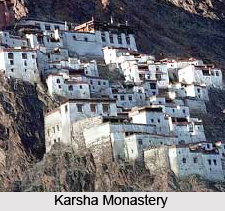 Karsha gompa is Zanskar`s largest Gelug-Pa monastery. After a long hiking trip, Karsha gompa gives a sense of satisfaction and makes your climb worthwhile. The huddle of whitewashed mud cubes hanging over the rocky lower slopes of the mountain north of Padum is dated from the tenth to fourteenth centuries. Amongst the prayer halls, the recently refurbished Du-Khang and Gon-Khang piled at the top are the most splendid of all. The small Chukshok-jal set at a distance from the gompa below the dilapidated fort contains Karsha`s ancient wall paintings.
The rapid way to arrive at Karsha on foot is to move towards north from Padum to the cable bridge across the Stod immediately below the monastery. Leave early in the morning so that the violent icy storms that blow in from the south across the Great Himalayan Range around mid-afternoon make the ninety-minute hike across the exposed river basin, something sort of a stamina test. Karsha is a far more pleasant place to stay than Padum and some villagers rent rooms to tourists. Try the wonderful glass room belonging to Thuktan Thardot in Sharling Ward just below the gompa.
Karsha gompa is Zanskar`s largest Gelug-Pa monastery. After a long hiking trip, Karsha gompa gives a sense of satisfaction and makes your climb worthwhile. The huddle of whitewashed mud cubes hanging over the rocky lower slopes of the mountain north of Padum is dated from the tenth to fourteenth centuries. Amongst the prayer halls, the recently refurbished Du-Khang and Gon-Khang piled at the top are the most splendid of all. The small Chukshok-jal set at a distance from the gompa below the dilapidated fort contains Karsha`s ancient wall paintings.
The rapid way to arrive at Karsha on foot is to move towards north from Padum to the cable bridge across the Stod immediately below the monastery. Leave early in the morning so that the violent icy storms that blow in from the south across the Great Himalayan Range around mid-afternoon make the ninety-minute hike across the exposed river basin, something sort of a stamina test. Karsha is a far more pleasant place to stay than Padum and some villagers rent rooms to tourists. Try the wonderful glass room belonging to Thuktan Thardot in Sharling Ward just below the gompa.
Karsha can be reached by road via the bridge at Tungri, 8km northwest of Padum. On the way you will find the large gompa of Sani glorified as the oldest gompa in Zanskar and the lone one built on the valley floor. Local legends point its establishment to the sage Padmasambhava in the eighth century. Nearby the temple, further to the north is a two-metre-high Maitreya statue, carved out of local stone some time between the eighth and tenth centuries.



















